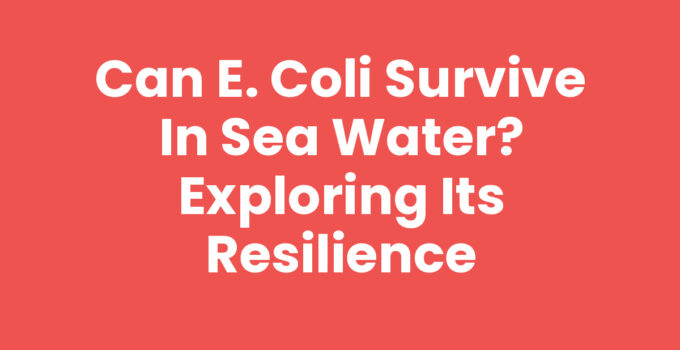Escherichia coli, commonly known as E. coli, is a type of bacteria that primarily resides in the intestines of humans and warm-blooded animals. While most strains of E. coli are harmless, some can cause serious foodborne illnesses. A question that often arises is whether E. coli can survive in sea water. Understanding this can help us better manage health risks associated with water quality, especially in coastal areas and popular recreational spaces. In this blog post, we’ll explore E. coli’s resilience in marine environments, implications for public health, and effective prevention strategies.
Can E. coli Survive in Sea Water?
Yes, E. coli can survive in sea water, but its survival depends on various environmental factors such as temperature, salinity, and competition with other microorganisms. Studies have shown that E. coli can remain viable for extended periods in marine environments under the right conditions. Below, we will break down the mechanisms that allow E. coli to endure in sea water and the factors that impact its survival.
Mechanisms of Survival
E. coli’s survival in seawater primarily hinges on:
- Osmoregulation: E. coli has the ability to adapt to changes in salinity. Under saline conditions, these bacteria implement mechanisms to maintain their internal osmotic balance, allowing them to survive in sea water.
- Protective Biofilms: In some instances, E. coli can form biofilms, a protective layer that shields them from environmental stresses. These biofilms can be beneficial in marine settings, providing E. coli a structured habitat in which they can thrive.
- Temperature Tolerance: E. coli can withstand a range of temperatures, which is crucial as seawater temperatures vary widely. Warmer temperatures can enhance their metabolic functions while cooler temperatures may slow them down without killing them.
Environmental Factors Affecting Survival
Several environmental factors influence the survival rate of E. coli in sea water:
- Salinity Levels: E. coli generally prefers environments with lower salinity levels. However, some strains can adapt to higher salinity to a certain extent.
- UV Radiation: Sunlight, particularly ultraviolet (UV) radiation, plays a significant role in the viability of E. coli in open water. Prolonged exposure to UV rays can decrease their numbers significantly.
- Nutrient Availability: The presence of organic matter in water can fuel the growth of E. coli and other bacteria. Higher nutrient levels often support bacterial growth, enhancing their survival rates.
Recommended Reading: Discover Beyers Street, Bloemfontein: A Local’s Guide
Health Implications of E. coli in Marine Environments
The potential for E. coli to survive in sea water raises significant concerns for public health:
- Waterborne Illnesses: If E. coli contaminates swimming areas or seafood, it can lead to gastrointestinal illnesses. In severe cases, it may cause kidney damage or other complications, particularly in vulnerable populations.
- Monitoring and Testing: Regular monitoring of water quality in coastal areas is crucial. Authorities often test for E. coli levels to ensure safe recreational water and seafood consumption.
- Microbial Source Tracking: Identifying sources of E. coli contamination helps manage and mitigate health risks effectively. Understanding whether the source is human or animal can influence local policy and management strategies.
Further Reading: What are the two capital cities of South Africa? Discover Now!
Preventive Measures to Combat E. coli
To reduce the risk of E. coli infections linked to sea water, several preventive measures can be implemented:
- Public Awareness: Educating the public about the risks associated with swimming in contaminated water can decrease the incidence of disease. Information on local water quality can also empower beachgoers.
- Improved Sewage Management: Preventing sewage discharge into public waters minimizes the potential for contamination. Local governments must prioritize infrastructure maintenance and upgrades.
- Health Guidelines for Seafood Consumption: Advising consumers to properly cook seafood and stay informed about local advisories helps reduce health risks associated with E. coli.
In conclusion, E. coli can indeed survive in sea water, aided by various biological mechanisms and environmental factors. This resilience presents potential health risks in coastal regions where water contamination can occur. By understanding how E. coli survives and implementing preventive measures, we can protect public health while enjoying recreational activities in and around marine environments.
Recommended Reading: Why do people move to Bloemfontein? Discover the Reasons
Frequently Asked Questions
Can E. coli be found in ocean water?
Yes, E. coli can be present in ocean water, especially near sewage outlets or contaminated areas.
What health risks are associated with E. coli in sea water?
Health risks include gastrointestinal illness and severe complications, particularly for vulnerable populations.
How can I avoid E. coli exposure while swimming?
Avoid swimming in water that is under a warning, and check for local advisories regarding water quality.



